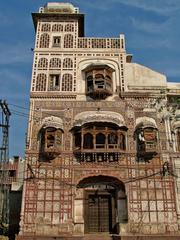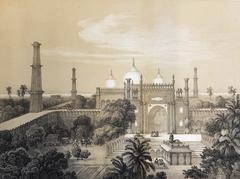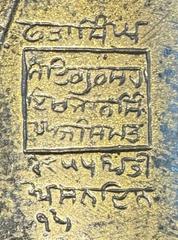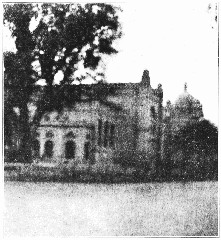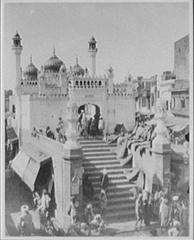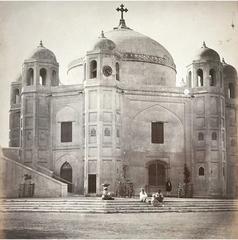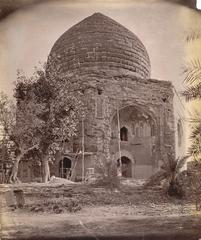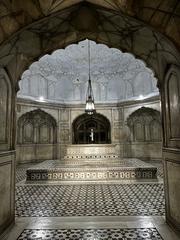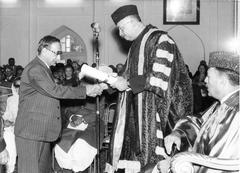Buddhu’s Tomb: Visiting Hours, Tickets, and Historical Significance in Lahore
Date: 04/07/2025
Introduction
Nestled along Lahore’s historic Grand Trunk Road, Buddhu’s Tomb—known locally as “Buddhu ka Maqbara” or “Buddhu ka Aawa”—offers a unique window into 17th-century Mughal heritage. Built circa 1641 AD during the reign of Emperor Shah Jahan, this monument stands out not only for its Mughal architectural features but also for its layered stories of local patrons, urban legends, and evolving cultural significance. Unlike Lahore’s grand imperial mausoleums, Buddhu’s Tomb commemorates a prominent non-royal figure: Buddhu, a wealthy brick kiln owner whose materials shaped much of Lahore’s Mughal landscape. Today, the tomb remains a testament to the city’s rich past, blending historical fact with folklore, and is accessible to all heritage enthusiasts seeking to delve into Lahore’s lesser-known historical treasures (Chughtai Library; Wikipedia: Buddhu’s Tomb; Secret Attractions).
Table of Contents
- Introduction
- Historical Overview
- Architectural Features
- Cultural and Religious Significance
- Visitor Information
- Preservation and Conservation
- Frequently Asked Questions (FAQs)
- Conclusion and Recommendations
- References
Historical Overview
Origins and Patronage
Buddhu’s Tomb was constructed around 1641 AD, during the zenith of Mughal architectural patronage under Emperor Shah Jahan (Chughtai Library). The tomb is traditionally attributed to Buddhu, a prosperous kiln owner who supplied bricks for major Mughal projects. Though local lore often identifies the tomb as Buddhu’s own mausoleum, historical research—such as Latif’s 1892 account—indicates it is actually the resting place of the wife of Khan-e-Daoran Nusrat Jang, a notable Mughal nobleman. This blend of fact and legend illustrates how Lahore’s urban memory intertwines documented history with folklore.
Mughal Lahore and the Tomb’s Context
The 17th century marked a golden era for Lahore, with the city emerging as a major center for Mughal administration, art, and architecture. Tombs, mosques, and gardens flourished, and the tradition of commemorating non-royal patrons in the Mughal style reflected the permeability of imperial aesthetics. Buddhu’s Tomb, while modest compared to the Tomb of Jahangir or Asif Khan, exemplifies the integration of local artisan classes into Lahore’s architectural landscape (Secret Attractions; Wikipedia: Buddhu’s Tomb).
Legends and Local Associations
Beyond its architectural role, the tomb is steeped in legend. Buddhu, known for his philanthropy, is the subject of tales involving curses and spiritual encounters, adding mystique to the site. The tomb’s alternative name, “Buddhu ka Aawa” (“Buddhu’s Kiln”), further cements its place in Lahore’s collective memory. During the Sikh era, the site was also venerated by Sikh communities and associated with the saint Bhai Kamliya (Punjab Heritage).
Architectural Features
Exterior and Layout
Buddhu’s Tomb is an octagonal, single-domed structure set on a raised plinth, with each side measuring roughly 20 meters. The design reflects classic Mughal funerary architecture, featuring red brick construction, pointed arched entrances, and a dome that sits atop an octagonal drum. The structure once boasted beautiful kashi kari (glazed tilework) in blue, turquoise, and white, remnants of which still adorn the exterior (Wikipedia: Buddhu’s Tomb).
Interior Details
Inside, visitors find a central chamber with a cenotaph. The interior is relatively austere but retains traces of frescoes and stucco ornamentation. The transition from square base to dome is achieved through squinches adorned with muqarnas (honeycomb) patterns, a hallmark of Mughal design. The tomb’s east-facing entrance aligns with Islamic funerary tradition.
Gardens and Surroundings
Originally enclosed within a Persian-inspired charbagh (four-part) garden, much of the landscaping has been lost to urban development. However, the remaining green space provides a tranquil environment, contrasting the bustling Grand Trunk Road nearby.
Cultural and Religious Significance
Buddhu’s Tomb occupies a unique place in Lahore’s cultural landscape. Its layered identity—as both a Mughal-era funerary monument and a site of local legend—reflects the city’s history of religious and cultural pluralism. The tomb symbolizes the possibility of social mobility in Mughal society, commemorating a non-royal figure whose economic and civic contributions were significant enough to merit monumental architecture.
Religiously, the tomb’s association with Sufi and Sikh traditions has made it a focal point for diverse communal gatherings, further enriching its cultural significance (Wikipedia: Buddhu’s Tomb).
Visitor Information
Visiting Hours and Entry Fees
- Opening Hours: Daily from 9:00 AM to 6:00 PM. For the best experience and lighting, visit during early morning or late afternoon.
- Entry Fee: Entry is free; however, voluntary donations for conservation are encouraged.
Directions and Accessibility
- Location: Grand Trunk Road, Begumpura, opposite University of Engineering and Technology (UET) Lahore.
- Getting There: Accessible by car, taxi, rickshaw, or Lahore Metro’s Orange Line (nearest stations within walking distance).
- Accessibility: Due to the raised plinth and uneven surfaces, the site has limited facilities for differently-abled visitors. Assistance from local guides is recommended for those with mobility challenges.
Visitor Etiquette and Tips
- Dress modestly in line with local customs.
- Photography is allowed, though it’s polite to seek permission before photographing people or religious gatherings.
- Respect the site by avoiding littering and not touching or climbing on the monument.
- Best Visiting Season: October to March, when the weather is cooler.
Guided Tours
While there are no official on-site guides, many Lahore-based tour operators include Buddhu’s Tomb in heritage walks, providing valuable context and insights (Apricot Tours: Lahore; Lahore Tours).
Nearby Attractions
Enhance your visit by exploring these notable sites:
- Shalimar Gardens (Shalimar Gardens): UNESCO World Heritage Site.
- Tomb of Asif Khan (Tomb of Asif Khan).
- Badshahi Mosque and Lahore Fort: Icons of Mughal grandeur.
- Walled City of Lahore (Walled City): Historic bazaars and gates.
Preservation and Conservation
Buddhu’s Tomb is protected under Pakistan’s Antiquities Act 1975. Nonetheless, urban encroachment, lack of sustained restoration, and environmental factors have taken a toll. Recent partial restoration efforts and the advocacy of local heritage organizations have improved conditions, but challenges remain due to limited resources and ongoing urban development (Chughtai Library). Ongoing initiatives aim to maintain the tomb’s structural and aesthetic integrity.
Frequently Asked Questions (FAQs)
Q: What are Buddhu’s Tomb visiting hours?
A: The site is open daily from 9:00 AM to 6:00 PM.
Q: Is there an entry fee or ticket?
A: No, entry is free for all visitors. Donations for conservation are welcome.
Q: Can I take photographs?
A: Yes, photography is permitted, but avoid flash and tripods. Be respectful during religious events.
Q: Is Buddhu’s Tomb accessible for disabled visitors?
A: Accessibility is limited due to historic features. Contact local guides for support if needed.
Q: Are guided tours available?
A: Yes, through local heritage tour operators.
Q: What are the nearby historical sites?
A: Shalimar Gardens, Tomb of Asif Khan, Badshahi Mosque, Lahore Fort, and the Walled City.
Conclusion and Recommendations
Buddhu’s Tomb is an evocative testament to Lahore’s rich Mughal heritage, blending imperial architectural traditions with stories of local artisans and evolving cultural meanings. Its modest scale belies the depth of its historical and social significance—from celebrating social mobility and urban patronage to serving as a locus for religious and cultural syncretism.
Open daily with no admission fee, the tomb invites travelers, historians, and cultural enthusiasts to experience a quieter, contemplative facet of Lahore’s past. Plan your visit during daylight hours, consider guided tours for deeper insight, and support conservation efforts to help preserve this landmark for future generations.
For enhanced travel planning, real-time updates, and more heritage site guides, download the Audiala app and follow heritage-focused platforms.
References
- Chughtai Library – Place Detail: Buddhu’s Tomb
- Detailed Architectural Study (PDF)
- Wikipedia: Buddhu’s Tomb
- Apricot Tours: Lahore
- Guide to Pakistan: Lahore
- Secret Attractions – Lahore Hidden Historical Sites
Images and interactive maps are recommended to accompany your visit, offering further insight into Buddhu’s Tomb’s architectural features and its context among Lahore’s historical sites.
